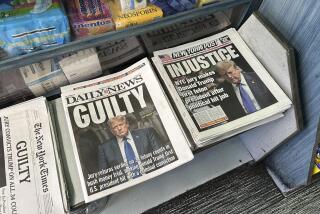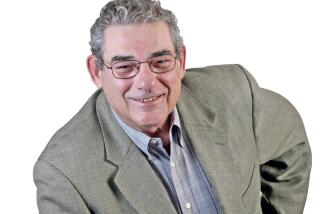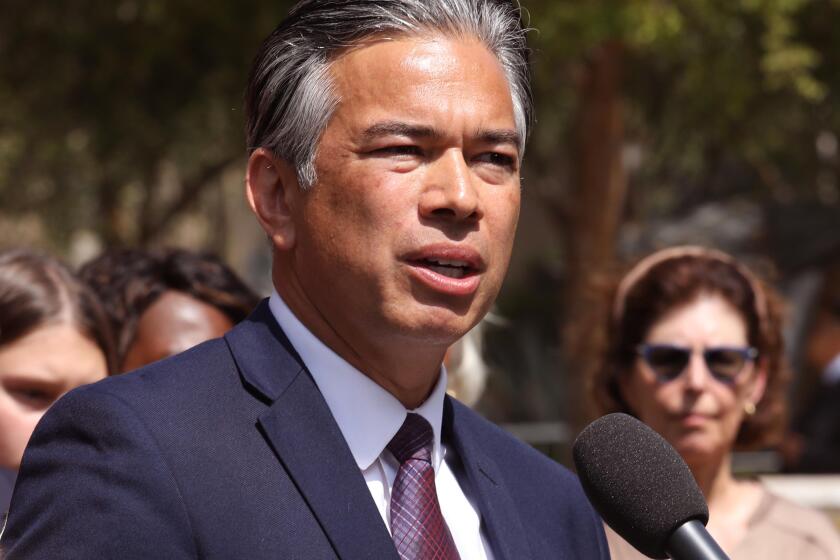Tunnel Vision : East Coast Bias Colors the Media
- Share via
An electrical engineer shoots four teen-agers who ask him for $5 on a New York subway, and he becomes a national folk hero--Bernhard Goetz, the “subway vigilante.”
A college dropout strangles an 18-year-old woman during a sexual tryst in New York’s Central Park, and it becomes a Big National Story--the “preppie murder case.”
For the record:
12:00 a.m. Dec. 2, 1988 For the Record
Los Angeles Times Friday December 2, 1988 Home Edition Part 1 Page 2 Column 5 Metro Desk 1 inches; 20 words Type of Material: Correction
The first name of Newsweek’s Houston bureau chief was incorrectly given in Part I of that series of stories. His correct name is Daniel Pedersen.
A young black woman says she was kidnaped and sexually abused by a gang of white racists in Newburgh, N.Y., and it becomes a national civil rights cause--the Tawana Brawley case.
Would these stories have attracted the same media attention had they happened anywhere but New York? Would the “CBS Evening News” have broadcast eight stories in 13 days on a subway vigilante in Chicago? Would Time magazine have published five stories on a preppie murder in San Francisco? Would Newsweek have published five stories on a Tawana Brawley case in Ypsilanti, Mich.?
For that matter, would New York Mayor Edward Koch and New York entrepreneur Donald Trump be the media darlings they are if they plied their respective trades in Seattle or Dallas? Would speculation about New York Gov. Mario Cuomo’s presidential aspirations--or New York Met Darryl Strawberry’s baseball aspirations--have been so thoroughly documented if these two men swung from the heels in Missouri?
Not very likely, judging from more than 100 interviews conducted by a Times reporter recently in 10 cities from New York to Los Angeles. These interviews reveal a widespread perception throughout the country that the nation’s media agenda, print and electronic, is largely shaped and driven--and sometimes, inevitably, distorted--by what interests and excites the media decision-makers living and working in New York, headquarters for most of the nation’s major news media.
Deciding the Issues
This is a matter of far more than intramural journalistic interest. Conservatives argue that the primacy of New York--and the secondary influence of Washington--ensures not just an eastern bias but a liberal bias in the media. Media executives deny that charge, but it is clear that, even discounting ideology, the decisions they make about which stories are worth covering and which are not largely determine what issues emerge on the national agenda for discussion and action by Congress, the courts, the White House and the body politic.
Many interviewees for this story said, for example, that because the New York media have historically been Euro-centric, they have been slow to cover the burgeoning economic power of Asia, the growth of the Pacific Rim and the enormous investment of Japanese money in American enterprises. Such major domestic issues as the drought, immigration and the taxpayers’ revolt of the late 1970s were also covered weakly or tardily by much of the national media because they were not issues that immediately affected or interested New Yorkers.
“The one example I would cite of the limitations of media being headquartered in New York that strikes me as particularly lamentable . . . is the emergence of Hispanic culture in the United States,” says Donald Pedersen, Newsweek’s bureau chief in Houston.
“It’s . . . one of the most profound elements of change in our culture . . . the story of the 1980s and 1990s if we look back on how American is changing,” Pedersen says. “We’re behind in recognizing that, (despite recent improvements).”
Clay Felker, former editor of New York and New West magazines and now editor of Manhattan Inc., says there is “no question” that New York stories get more coverage than those elsewhere.
“Journalists and people in communications in general summer together . . . and they party together and they do business together. . . . There’s no overt conspiracy; it’s just the way things are,” Felker says. “It’s self-evident (and) . . . self-perpetuating.”
New York, New York
When something happens in New York, the people who run ABC, CBS and NBC, the New York Times and the Wall Street Journal, the Associated Press, Time and Newsweek and virtually all the other major national magazines and major book publishers read about it in their local (i.e., New York) newspapers, hear about it on local, all-news radio, see it on local television news programs and talk about it with their friends and colleagues.
It’s not surprising--indeed it’s probably quite natural--that these people would think everyone, everywhere, is interested in the same story they’re interested in, whether it’s a heinous crime, a Broadway opening, a big sports event or a controversial politician.
People in Detroit and Denver and Dallas probably feel the same way when something noteworthy happens in their cities. But the people living in Detroit and Denver and Dallas don’t control the nation’s major media outlets. The people in New York do--and they live in the world’s largest echo chamber, with far more news outlets than any other American city, many with a national audience (and a few blaring the day’s happenings in a uniquely breathless-cum-alarmist style).
Thus, “news” is often defined as what happens in and to New York--and in the surrounding Boston-New York-Washington corridor, linked by Amtrak trains and hourly air shuttle flights and encompassing the federal government, the major think tanks, the most prestigious universities in the country and several other major news outlets, most notably the influential Washington Post.
As Peter Applebome, Houston bureau chief for the New York Times, puts it:
“There’s so much media in New York and Washington . . . so many people jumping to stretch each little sliver of significance out of some of these stories, that it just magnifies what happens there.”
Not only do the people in the Boston-New York-Washington corridor make most of the news; they are also asked to explain and analyze the news for everyone else. Reporters for news media both inside and outside that corridor invariably turn to “experts” inside that corridor--politicians, scholars, consultants, other journalists--for quotes and comments on the day’s happenings.
(When I wrote about the changing role of the press in the political process earlier this year, 28 of the 34 sources I quoted live and work in that corridor.
(“If someone dropped a hand grenade on a just one Georgetown cocktail party almost any Friday night, everyone you quoted would have been killed,” John Balzar, a Los Angeles Times political writer, grumbled, with only a touch of hyperbole.)
Molly Ivins, formerly a reporter for the New York Times and now a columnist for the Dallas Times Herald, says this “journalistic provincialism” is “especially galling because . . . when you have provincialism in a center of power like Washington or New York, it always winds up being imposed on others and distorting reality, making it look like they’re the only ones who know what’s going on in the world.”
Some complaints about a “New York myopia” or an “eastern bias” in the media is sour grapes--a defensive, parochial and overly sensitive reaction to the unquestioned role of New York (and to a lesser extent, Washington) as a center of power in American life.
Writing about New York isn’t always bias, it’s “just recognizing King Kong when he breaks into your bathroom,” says Jack Kroll, a senior editor at Newsweek.
But for many media decision-makers in New York, it sometimes seems that every monkey’s uncle within 10 miles of the Empire State Building looks like King Kong.
Perhaps the classic instance of this eastern corridor tunnel vision was the publication of Newsweek’s June 20 cover story, “Washington vs. New York.”
Did the rest of the nation really want to read a seven-page cover story on the “rivalry” between these two cities?
“People are fascinated by both places,” says Tony Fuller, the magazine’s national affairs editor.
Not that fascinated, apparently.
Newsweek sold only 139,000 copies of that issue on the newsstands; 47 of the magazine’s previous 50 issues sold better--an average of 30% better overall.
Newsweek correspondents in other bureaus say the “Washington vs. New York” story was arrogant provincialism. But virtually everyone is provincial, in one way or another; virtually everyone sees the world through his or her own experiences and overvalues that which is nearest and dearest.
In New York, though, many people tend to be less aware of their provincialism than others are. After all, how can anyone who lives in so sophisticated and cosmopolitan a city be provincial?
Dangers of Concentration
Editors in New York insist they are acutely aware of the dangers attendant on their all being headquartered in the same city. At one time or another early in their history, Time, Newsweek and the Wall Street Journal all considered trying to relocate outside New York to avoid those dangers.
The Journal still makes a greater--and more successful effort--than most publications to avoid being overly influenced by what happens in New York. Two-thirds of the paper’s reporting staff is based outside New York; its national reporting for the retail industry is based in Chicago; its energy reporting is based in Houston.
Interestingly, despite their focus on Wall Street, New York-based business publications in general seem to do a better job of avoiding New York myopia than do more general-interest publications also based in New York.
This may be because the editors of business publications know their readers are especially sensitive to national trends and issues in their own businesses, says C. Shelby Coffey III, who has edited publications in Washington and Dallas and is now executive editor of the Los Angeles Times.
But the major general-interest publications (and the networks) also have bureaus and readers (and viewers) around the country, and they say they also try to escape the New York myopia. Often, they say, they give less--or later--attention than they should to significant New York stories, precisely because they don’t want to be perceived as provincial or parochial.
The New York Times, in its national edition, now changes its front page perhaps three times a week to “remove . . . or play down . . . any local (New York) story that we think is not of interest or is of less interest to the national reader,” says David Jones, editor of the national edition.
Henry Muller, managing editor of Time, enjoys telling a story about his resistance to suggestions from subordinates earlier this year that the magazine do a story on the Yonkers housing integration crisis .
“They tried for weeks to persuade me to do it, but I thought it was too New York,” he says. “Finally, I told them to find me some non-New York, non-Washington stories. I asked them to call our bureaus around the country and get something from out there.”
‘Honesty Check’
Moments later, Muller recalls, he glanced at the front page of the Los Angeles Times, which he says he looks at every day as “my . . . honesty check” against the New York-Washington bias.
“What did I see on the front page--a story on Yonkers.”
But such examples are exceptions to the New York myopia. As the song “New York, New York,” says, “If I can make it there, I’ll make it anywhere,” and it is this sense of being “in the big leagues . . . being around other major-leaguers in different fields . . . (that) gradually, almost imperceptibly closes off your world,” says William Broyles, former editor of Newsweek, Texas Monthly and California magazines and now the co-creator of the television show “China Beach.”
“Often, when I lived in New York, I got the feeling that people’s idea of communing with the country was listening to Bruce Springsteen records,” Broyles says.
When Broyles was editor of Newsweek from 1982 to 1984, he tried to avoid that syndrome, to make the magazine more genuinely national in scope. He hired several editors from the West, tried to bring a Western sensibility to story selection and editing and even bought several daily subscriptions to the Los Angeles Times for delivery to his Newsweek colleagues.
No One Read It
But no one at Newsweek except Broyles himself read the Los Angeles Times regularly, he says, and in time, he, too, stopped reading it.
Even well-meaning editors often wind up in an “inevitable cocoon” that shuts out what does not affect them personally, Broyles says. These editors may occasionally publish stories on issues outside the East Coast, but “they’re just stories . . . words on paper. . . . It’s the difference between doing a story and understanding a way of life.
“Even having come from Texas and gone to New York with the express agenda to bring . . . stories from different parts of the country into the magazine . . . the longer I lived in New York, the more the rest of the country just seemed to slowly fade away,” Broyles says. “It’s the limitations of very human people who are caught up in a very powerful, very addictive world. . . . You really do feel like you’re at the center of it all.”
Abbreviated Landscape
Time and again in interviews for this story, people invoked the image of the 1976 New Yorker magazine cover by Saul Steinberg, the now-famous poster that shows a New Yorker’s view of the world: Two blocks of Manhattan occupy almost the entire foreground, with the Hudson River and “Jersey” beyond that and, receding in the distance, largely undifferentiated and scrunched together, Chicago, Texas, Nebraska, Los Angeles . . . and then the Pacific Ocean and--finally, barely visible on the horizon--slivers of land mass representing China, Japan and Russia.
The myopia symbolized in this drawing is not a phenomenon unique to the United States. Many countries have an all-powerful capital--Paris, say, or London--and the provinces “out there,” as many New York media moguls refer to the rest of the United States. This country actually has several capitals--Washington, the government capital; Detroit, the automotive capital; Los Angeles, the pop culture capital.
In fact, Los Angeles--despite being almost 3,000 miles from New York--now fares much better with the eastern media than does the rest of America that lies between the two coasts, the vast middle America known to the bi-coastal business travelers as “fly-over” country.
Not only is Los Angeles a media center itself--the creative center for the television and motion picture industries--but “there is a feeling (in New York) that a story about New York, Washington or Boston will be understood in Los Angeles and San Francisco and not in-between,” says David Corvo, executive producer for the “CBS Morning News.”
Still, it is New York--the financial capital, the high culture capital, the fashion capital, the communications capital--that determines the national agenda, even, ironically, as the television networks and national newsmagazines often seem preoccupied with Washington.
Washington is where most newspapers, including the Los Angeles Times, have their largest bureaus, and Washington is where official “news,” the news that is most visible and easiest to cover--votes, hearings, statements, speeches, rulings--most consistently happens.
“Our bias in the (Nation) section tends to be, if anything, toward politics and toward Washington,” says Walter Isaacson, editor of the Nation section at Time when he was interviewed for this story and now a senior writer at the magazine.
Constant Battle
Editors at Newsweek say much the same thing, and editors at both magazines and at the networks speak of the constant battle to “get out of Washington” with their coverage.
The evening network news shows have only 22 minutes to cover the world, though, and with recent economic cutbacks, most now have fewer bureau reporters to cover the news in the rest of the country.
“That lessens your chance of getting anything on the ‘CBS Evening News,’ ” says Harvey Goldberg, former CBS bureau chief in Chicago and now executive producer at WDIV in Detroit.
The newsmagazines also have limited space--compared to most major daily newspapers--and when the week’s news from abroad and from Washington is covered, there often is little time left for anything else, especially in a presidential campaign year.
Thus, important issues and problems can exist for years outside Washington and receive little, if any, national media coverage, but once there is a congressional hearing, the national media engine roars to life.
The Atlanta Constitution has been writing for years about dangerous conditions involving the nuclear reactor at the Savannah River Plant near Aiken, S.C., but the East Coast-based media paid little attention. Then, early last month, two congressional committees disclosed that several serious reactor accidents had been kept secret from the public for years.
VAAAAROOOOMMM!
Seven Page 1 stories in the New York Times in nine days. Coverage on all three networks. A full-page story in Time. Daily stories on all the major wire services.
Bill Kovach, former Washington bureau chief of the New York Times and former editor of the Atlanta Constitution, said while still in Atlanta that once he left the Northeast, “it’s amazing how much of that (syndrome) I feel and see.”
Kovach said he also is amazed by how many stories of “truly national importance . . . (are) done by papers all over the country that I had never heard about . . . because they didn’t filter through . . . the national media . . . the New York Times or Washington Post or Time or Newsweek in any sustained fashion. . . .”
Many other editors who, like Kovach, left Washington (or New York) to work in the media elsewhere say the first and most startling lesson they learn on their new job is how little most people “out there” really care about what happens in Washington (or New York) on a daily basis.
News Follows Power
“The difference between what those people inside the (Washington) Beltway think matters and what really does matter to the rest of the country is laughable,” says David Burgin, who worked for the Washington Star and is now editor-in-chief of the Houston Post.
But news follows power, and Washington is the seat of official power--as validated by New York. It is New York where most of the top editors for the national media work and where the decisions made in Washington and elsewhere are evaluated and passed on (or not passed on) to the rest of the country.
In recent years, in fits and starts, there has been some evidence of a small, subtle shift in this balance of power--gradual and tentative change, but change nonetheless.
When Van Gordon Sauter was president of CBS News in the early and mid-1980s, he tried to take the evening newscast out of Washington more--much as Broyles was doing at the same time at Newsweek. Both men wanted to pay less journalistic attention to the governmental decision-makers and more to the average Americans affected by these decisions. Broyles and Sauter even use similar metaphors to describe their efforts; Broyles speaks of doing stories “through the other end of the telescope,” and Sauter of trying to “show news from the . . . prism . . . of the consumer.”
Considerable Resistance
But both men met considerable resistance from traditionalists on their staffs. Both were widely criticized--not without justification--for trivializing the news. Both had relatively short tenures.
Now, however, Sauter says, the influence of the “attitudinal incestuousness (in) . . . the Cambridge-Manhattan-Georgetown axis is in a perceptible decline” as new people come into power at the networks, “people . . . (who) have worked around the country . . . and . . . have greater empathy for . . . and interest in . . . those who live more than 15 miles from the Atlantic Ocean.”
The new generation is “more broadly traveled, has a broader vision of the country, is less elitist and more commercially oriented” than its predecessors, more sensitive to the declining network television audiences, Sauter says.
Cable News Network, based in Atlanta, has further loosened the networks’ (and the New York/Washington) stranglehold on television news. James D. Squires, editor of the Chicago Tribune, says the growth of such national newspaper chains as Knight-Ridder Inc., Times Mirror and the Tribune Co. and the success of USA Today have also helped “offset . . . the impact . . . of East Coast bias.”
USA Today--although based in the Washington suburb of Arlington, Va.--has a determinedly heartland philosophy that is clearly having “considerable impact . . . in sort of raising our consciousness about stories elsewhere,” says Tony Fuller, national affairs editor at Newsweek.
Editors at Time give USA Today similar credit.
USA Today is so resolute in its efforts to “stamp out eastern bias”--as the paper’s senior editor Taylor Buckley puts it--that there are periodic staff meetings and memos on the subject; Buckley has been known to grumble about such subtle indications of this “bias” as nationwide news roundups that always begin with news from the East and work their way West.
Even the Pulitzer Prizes, the top awards in newspaper journalism and long a bastion of East Coast domination, have begun to look more often beyond the Mississippi River of late. For most of this century, the Pulitzer Prizes were largely a self-perpetuating phenomenon: The predominantly eastern members of the Pulitzer Prize Board selected predominantly eastern journalists to serve on the Pulitzer nominating juries; the juries then sent predominantly eastern nominations to the predominantly eastern board, which chose predominantly eastern prize-winners.
Although the composition of the board has not changed significantly in recent years, the composition of the juries--and the nominees and winners--has changed. From 1974 to 1983, jurors from the eastern half of the United States outnumbered jurors from the western half by a ratio of 3 1/2 to 1; this year the ratio was only 4 to 3. From 1970 to 1983, about 90% of the Pulitzer Prize nominees and winners were from east of the Mississippi; in the last four years, the percentage has dropped to about 65%.
All these changes in the media have come--not coincidentally--at a time when population (and power) have been shifting from the urban Northeast to the Sun Belt. Twelve of the 30 most populous metropolitan areas in the country are now in the West and Southwest. Ten others are in the South and Midwest. Many of the major socio-political developments of the last two decades--the conservatives’ rise to power, the taxpayers’ rebellion, the environmental and slow-growth movements, the dramatic growth of the immigrant population--have started in the West.
Moreover, there are now first-rate opera seasons in San Francisco and Santa Fe, N.M., and exciting, highly regarded regional theaters in La Jolla and Seattle--and, simultaneously, a World Series champion, a professional basketball dynasty and a hockey superstar in Los Angeles.
But the media capital--the media power, the media agenda-setting--remains in New York, and that means the media continue to have a New York or, more broadly speaking, an East Coast sensibility, the best intentions of many top media leaders notwithstanding.
Janet Lundblad of The Times editorial library assisted with the research for this story.
More to Read
Sign up for Essential California
The most important California stories and recommendations in your inbox every morning.
You may occasionally receive promotional content from the Los Angeles Times.










